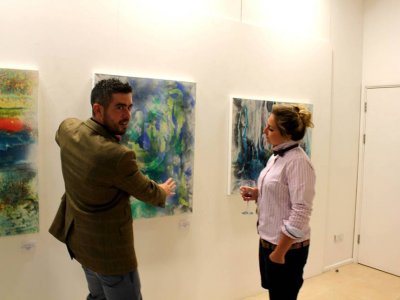
James Derwin / News / Thu 21 Apr 2011
Immersive Worlds, Art Exhibition Review By Amelia Marriette

I have just walked in from the dazzling April sunshine into the dark, immersive world of the Spanish Barn at Torre Abbey. As my eyes adjusted to the gloom – I first noticed the black, gothic nature of the exhibition. It drew me in. This is an interesting reversal of the clean, white gallery and immediately alerted me that this exhibition is intended to challenge that view: a great start.
I heard the beat and thud of the sound installation. Then I saw a common or garden shed or Running Machine – Sound Project. Opening the door, I stooped (I am tall) and went in. Truly immersive – dark, womb-like and of course (Freud would love this) immediately and strangely comforting. The darkness is complete, but Rik Pitman has provided an orange portal, a place to put one’s hand, to feel the heartbeat sound as it resonates: like experiencing a baby-scan from the inside. It is actually a recording of a mile on a treadmill, but of course, it is more than that. The ‘heart-beat’ of the feet are life itself, the sheer relentlessness of it, or perhaps, more positively, a reminder that life goes on, and on and on regardless and without cessation.
Beth Jenkins piece, Lenses I, has humour – at last a piece of contemporary art that can raise a smile. Hundreds of pairs of spectacles, painstakingly wired together to make a chandelier. A chandelier that you can stand in and look through: the distorted images creating a new view of an old world. Clever and poignant too, as the glasses are all recycled and have their own stories to tell.
But Clem So’s video installation Tracing the Intangible is a star piece: beautiful to watch, mesmerising and thoughtful, abstract in a way which is thrilling without being obtuse. Please just go and see it, after it finishes stay put and watch Michele Whiting’s short film Coast this too is a triumph. Slapton Sands on a hot, sunny day. People lying casually, thoughtlessly – as in without thought - one might say – on the ground. Then a ghost of soldiers melt into the frame. They stand motionless in and around a landing craft – superimposed over the slow-motion 21st century figures, who know little or even nothing of the supreme sacrifice made there in that place, for them, for us. This could be crude and obvious, but it is not. Towards the end of Whiting’s film a small fragment of Powell and Pressburger’s film A Matter of Life and Death sneaks in, this is a genius touch: a bizarre war-film (from the period, 1946) made by a surreal partnership of a Brit and a Hungarian. Use of this fragment adds a touch of the uncanny to the now three layers that we are watching. Finally at the end of the piece a little girl, innocently sporting a jersey with a ‘roundel’ on it strolls past. This poignantly echoes the planes with their white, red and blue ‘targets’. Just as the fade occurs a man swings his child round casually as if to throw her into the sea – this is play, but the history just seen was real.
My congratulations go to James Derwin, the curator, and all the artists, technicians and volunteers who must have worked so very hard to get this show on the road. Rain or shine, it’s a really good show, and there is much more to see than I have had time to analyse, but that’s where you come in! Go and see it – it’s FREE!
Amelia Marriette, Exhibitions and Collections Curator, Torbay Council.
For more information visit http://creativetorbay.com/listings/events/?id=15611&view=list
